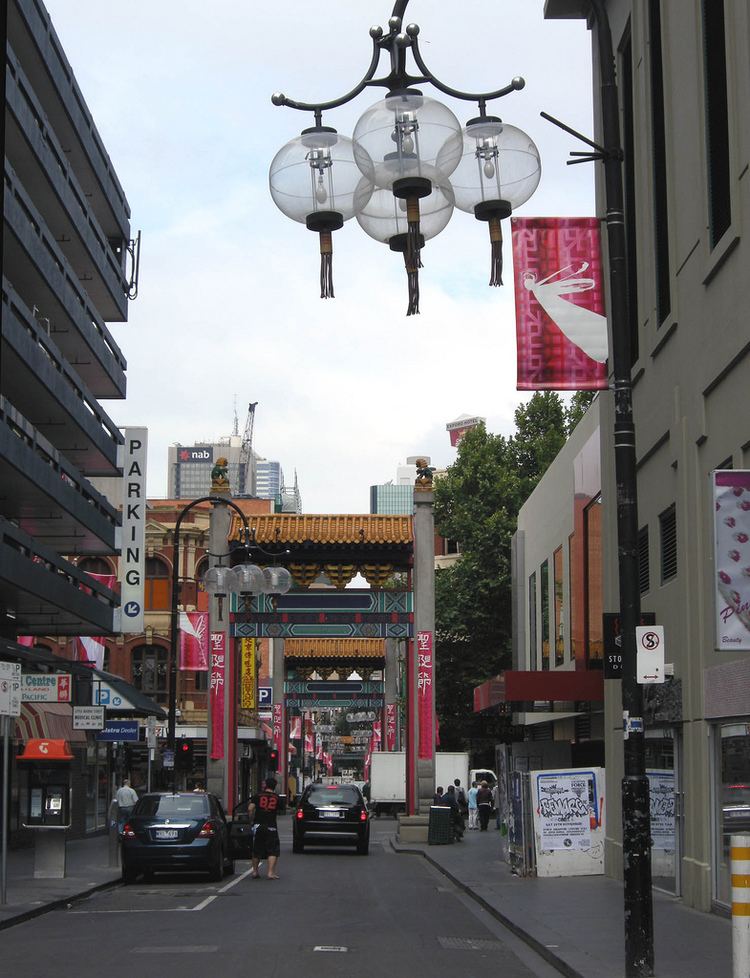 | ||
Hours Open today · Open 24 hoursSundayOpen 24 hoursMondayOpen 24 hoursTuesdayOpen 24 hoursWednesdayOpen 24 hoursThursdayOpen 24 hoursFridayOpen 24 hoursSaturdayOpen 24 hours Similar Chinese Museum - Melbourne, Melbourne Central Shopping, Queen Victoria Market, Flinders Street railway st, Melbourne City Centre | ||
Chinatown in Melbourne, Australia is located within the Melbourne city centre, centred at the eastern end of Little Bourke St. It extends between the corners of Swanston and Spring Streets. It is notable for being the longest continuous Chinese settlement in the Western World and one of the oldest Chinatowns in the Southern Hemisphere.
Contents
Since its inception in 1854 and the arrival of Chinese immigrants to Melbourne, the city's Chinatown has played an important role in establishing the history and culture of the ethnic Chinese immigrants in Australia. When an increasing interest in an ethnic variety of food and culture peaked in the 1970s and 1980s, Chinatown fuelled the growth of many restaurants, cafes, businesses and places of worship. Today, Melbourne's Chinatown is a major tourist attraction home to a variety of business and well known for its varied restaurants offering cuisines of Chinese, Thai, Japanese, Indian, Malaysian, Vietnamese and Korean origins.
Early history
Melbourne's Chinatown has a long and illustrious history. It was established during the Victorian gold rush in 1851 when Chinese prospectors came to Australia for the gold rush in search of gold. In late 1854, the first Chinese lodging houses were created in Little Bourke Street and Celestial Avenue (off Little Bourke Street). This particular location was considered convenient for the immigrants, as it was a staging post for new Chinese immigrants as well as supplies en route to the goldfields. It is notable for being the oldest Chinatown in Australia, the oldest continuous Chinese settlement in Australia, and the second longest continuous Chinese settlement in the western world, only because San Francisco's Chinatown was nearly, but not completely destroyed by the 1906 earthquake. The gold rush eventually waned, causing a shift from rural living and an influx of people migrating into metropolitan Melbourne, particularly Little Bourke Street, which already had a predominantly Chinese population.
The Chinese established themselves as storekeepers, importers, furniture-makers, herbalists and in the wholesale fruit and vegetable and restaurant industries. Christian churches were built and Chinese political groups and newspapers were subsequently formed. Other members of the Chinese community who lived and worked elsewhere used Chinatown to congregate with friends. The area also provided further support to new Chinese immigrants. Early in its history, during a thriving period in the 1850s, Chinatown housed "salubrious" enterprises including opium dens, brothels and boarding houses, but maintained a distinctly "entrepreneurial air".
From 1900–1920, the Chinatown peaked in terms of population and activity, which was hampered by the 1901 Immigration Restriction Act and a general shift of businesses and residents from the Melbourne's central business district (CBD). The Dim Sim was invented in Chinatown, by William Wing Young, in 1945, at his restaurant Wing Lee, and has become a major snack food in takeaway outlets and Chinese restaurants throughout the entire country. European residents of Melbourne and university students of the city began frequenting Chinatown eateries in the 1930s, leading to gradual mainstream Australian popularity which boomed in the 1960s–70s. This boom was further enlarged by the re-development, at the request of Chinatown entrepreneur David Neng-Hsiang Wang, of Little Bourke Street leading to the archway's of today.
1970s–present day
The Southern Chinese people (who first settled in Melbourne) were the first Chinese Australians to bring Chinese cuisine to Australia, although recently more Northern Chinese food has become common. Chinese food was the first international cuisine to become popular through the take away food market in Australia. The 1970s and 80's also saw the eradication of the controversial discriminatory immigration regulations, which saw immigration from Indochina, Singapore, Malaysia, Taiwan, Hong Kong and the People's Republic of China. In 2010, the ground floor of the Chinese Museum was remodeled as a visitor centre for Melbourne's Chinatown. In 2011, a Memorial statue of Dr Sun Yat-sen was unveiled outside the Museum's entrance in celebration of the 100th anniversary of the founding of the Republic of China. The traditional Chinese New Year Lion Dance has always ended at this spot, but will now end with a blessing of the statue.
Chinese New Year
The Chinese New Year is primarily celebrated in Chinatown on the first Sunday of the new Lunar year. It is the original and primary location of Melbourne's CNY festival, although the festival has expanded to multiple CBD sites in recent years, including Crown Casino. The celebrations feature traditional and contemporary Chinese cultural activities and festivities, dances, Chinese opera and singing, karaoke competition, numerous stalls of culinary delights, arts and crafts, Chinese chess competitions, calligraphy and children's events.
The Dai Loong Dragon Parade, as well as the main Lion Dances(performed by the Chinese Youth Society of Melbourne, Chinese Masonic Society and Hung Gar Martial Arts School) begin at roughly 10am on the Sunday following New Year, and run till roughly 4pm. The Dragon parade begins and ends at Melbourne's Chinese Museum.
Asian Food Festival
The Asian food festival is typically held in Spring and celebrates Asian cuisine with food tasting, stalls, cooking demonstrations, among others.
Other Chinese communities
Other than the original Chinatown in the CBD, several newer Chinese communities, with immigrants primarily of Cantonese descent, are found in the suburbs of Melbourne, such as Box Hill, Glen Waverley and Springvale.
An older community, with links back to the 1850s gold rush, is to be found in Bendigo, a country Victorian city that was once a goldmining destination during the 19th century.
